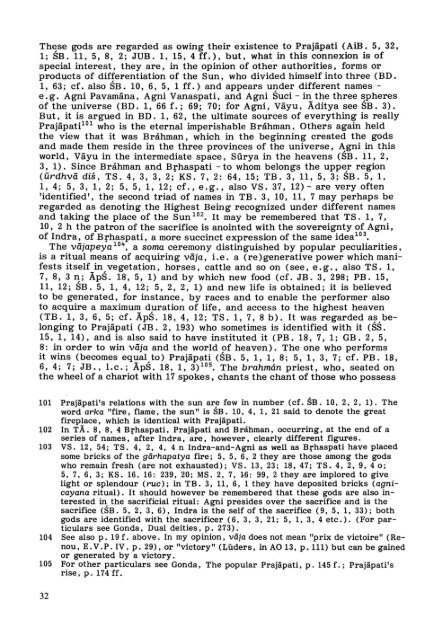Prajapati's relations with Brahman, Brhaspati and Brahma - DWC
Prajapati's relations with Brahman, Brhaspati and Brahma - DWC
Prajapati's relations with Brahman, Brhaspati and Brahma - DWC
You also want an ePaper? Increase the reach of your titles
YUMPU automatically turns print PDFs into web optimized ePapers that Google loves.
These gods are regarded as owing their existence to Prajäpati (AiB. 5, 32,<br />
1; SB. 11, 5, 8, 2; JUB. 1, 15, 4 ff.), but, what in this connexion is of<br />
special interest, they are, in the opinion of other authorities, forms or<br />
products of differentiation of the Sun, who divided himself into three (BD.<br />
1, 63; cf. also SB. 10, 6, 5, 1 ff.) <strong>and</strong> appears under different names -<br />
e. g. Agni Pavamäna, Agni Vanaspati, <strong>and</strong> Agni Suci - in the th ree spheres<br />
of the universe (BD . 1, 66 f.; 69; 70; for Agni, Väyu, Äditya see SB. 3).<br />
But, it is argued in BD. 1, 62, the ultimate sources of everything is really<br />
Prajäpati 101 who is the eternal imperishable Bráhman. Others again held<br />
the view that it was Bráhman, which in the beginning created the gods<br />
<strong>and</strong> made them reside in the three provinces of the universe , Agni in this<br />
world, Väyu in the intermediate space, Sürya in the heavens (SB . 11, 2,<br />
3, 1). Since Bráhman <strong>and</strong> <strong>Brhaspati</strong> - to whom belongs the uppep region<br />
(ürdhvä dis, TS. 4, 3, 3, 2; KS. 7, 2: 64,15; TB. 3, 11, 5, 3; SB. 5, 1,<br />
1,4; 5,3, 1,2; 5,5, 1, 12; cf., e.g., also VS. 37, 12) - are very often<br />
'identified', the second triad of names in TB. 3, 10, 11, 7 may perhaps be<br />
regarded as denoting the Highest Being recognized under different names<br />
<strong>and</strong> taking the place of the Sun 102. It may be remembered that TS. 1, 7,<br />
10, 2 h the patron of the sacrifice is anointed <strong>with</strong> the sovereignty of Agni,<br />
of Indra, of <strong>Brhaspati</strong>, a more succinct expression of the same idea 103 •<br />
The väjapeya 10'+, a soma ceremony distinguished by popular peculiarities,<br />
is a ritual means of acquiring väja, i.e. a (re)generative power which manifests<br />
itself in, vegetation, horses, cattle <strong>and</strong> so on (see, e. g., also T S. 1,<br />
7,8,3 n; ÄpS. 18,5,1) <strong>and</strong> by which new food (cf. JB. 3, 298; PB. 15,<br />
11,12; SB. 5,1,4,12; 5,2,2,1) <strong>and</strong> new life is obtained; it is believed<br />
to be generated, for instance, by races <strong>and</strong> to enable the performer also<br />
to acquire a maximum duration of life, <strong>and</strong> access to the highe st heaven<br />
(TB. 1, 3, 6, 5; cf. ÄpS. 18, 4, 12; TS. 1, 7, 8 b). It was regarded as belonging<br />
to Prajäpati (JB. 2, 193) who sometimes is identified <strong>with</strong> it (SS.<br />
15,1,14), <strong>and</strong> is also said to have instituted it (PB. 18, 7, 1; GB. 2, 5,<br />
8: in order to win väja <strong>and</strong> the world of heaven). The one who performs<br />
it wins (becomes equal tol Prajäpati (SB. 5, 1, 1, 8; 5, 1,3, 7; cf. PB. 18,<br />
6,4; 7; JB., l.c.; ÄpS. 18, 1, 3)105. The brahmán priest, who, seated on<br />
the wheel of a chariot <strong>with</strong> 17 spokes, chants the chant of those who possess<br />
101 Prajäpati's <strong>relations</strong> <strong>with</strong> the sun are few in number (cf. SB. 10, 2, 2, 1). The<br />
word arka "fire , flame, the sun" is SB. 10, 4, I, 21 said to denote the great<br />
fireplace, which is identical <strong>with</strong> Prajäpati.<br />
102 In T Ä. 8, 8, 4 <strong>Brhaspati</strong>, Prajäpati <strong>and</strong> Bráhman, occurring, at the end of a<br />
series of names, after Indra, are, however, clearly different figures.<br />
103 VS. 12, 54; TS. 4, 2, 4, 4 n Indra-<strong>and</strong>-Agni as weU as <strong>Brhaspati</strong> have placed<br />
some bricks of the gärhapatya fire; 5, 5, 6, 2 they are those among the gods<br />
who remain fresh (are not exhausted) ; VS. 13,23; 18,47; TS. 4, 2, 9, 40;<br />
5,7,6,3; KS. 16, 16: 239,20; MS. 2, 7, 16: 99,2 they are implored to give<br />
light or splendour (ruc); in TB. 3, 11,6, 1 they have deposited bricks (agnicayana<br />
ritual). It should however be remembered that these gods are also interested<br />
in the sacrificial ritual: Agni presides over the sacrifice <strong>and</strong> is the<br />
sacrifice (SB. 5, 2, 3, 6), Indra is the self of the sacrifice (9, 5, I, 33); both<br />
gods are iden tified <strong>with</strong> the sacrificer (6, 3, 3, 21; 5, I, 3, 4 etc.). (For particulars<br />
see Gonda, Dual deities , p. 273) .<br />
104 See also p. 19 f. above. In my opinion, väja does not mean "prix de victoire" (Renou,<br />
E. V.P. IV, p. 29), or "victory" (Lüders, in AO 13, p. 111) but can be gained<br />
or generated by · a victory.<br />
105 For other particulars see Gonda, The popular Prajäpati, p. 145 f.; Prajäpati's<br />
rise, p. 174 ff.<br />
32
















